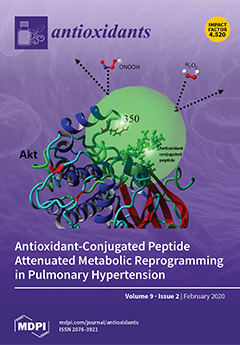Cassia fistula L. is a highly admirable traditional medicinal plant used for the treatment of various diseases and disorders. The present study was performed to divulge the antioxidant, antiproliferative, and apoptosis-inducing efficacy of fractions from
C. fistula leaves. The hexane (CaLH fraction), chloroform
[...] Read more.
Cassia fistula L. is a highly admirable traditional medicinal plant used for the treatment of various diseases and disorders. The present study was performed to divulge the antioxidant, antiproliferative, and apoptosis-inducing efficacy of fractions from
C. fistula leaves. The hexane (CaLH fraction), chloroform (CaLC fraction), ethyl acetate (CaLE fraction),
n-butanol (CaLB fraction), and aqueous (CaLA fraction) were sequentially fractionated from 80% methanolic (CaLM extract) of
C. fistula leaves. The CaLE fraction was fractionated using column chromatography to yield a pure compound, which was characterized as Epiafzelechin (CFL1) based on
1H,
13C, and DEPT135 NMR. Among these fractions, CaLE and isolated CFL1 fractions exhibited an effective antioxidant potential in Ferric ion reducing power, (2,2’-azino-bis (3-ethylbenzothiazoline -6-sulfonic acid)) cation radical scavenging, and nitric oxide radical scavenging assays. Epiafzelechin was investigated for its antiproliferative effects against MG-63 (osteosarcoma), IMR-32 (neuroblastoma), and PC-3 (prostate adenocarcinoma), and was found to inhibit cell proliferation with a GI
50 value of 8.73, 9.15, and 11.8 μM respectively. MG-63 cells underwent apoptotic cell death on treatment with Epiafzelechin as the cells showed the formation of apoptotic bodies, enhanced reactive oxygen species (ROS) generation, mitochondrial membrane depolarization along with an increase in early apoptotic cell population analyzed using Annexin V-FITC/PI double staining assay. Cells showed cell cycle arrest at the G
0/G
1 phase accompanied by a downregulation in the expression levels of p-Akt (Protein kinase B), p-GSK-3β (Glycogen synthase kinase-3 beta), and Bcl-xl (B-cell lymphoma-extra large) proteins. RT-PCR (Real time-polymerase chain reaction) analysis revealed downregulation in the gene expression level of β-catenin and CDK2 (cyclin-dependent kinases-2) while it upregulated the expression level of caspase-8 and p53 genes in MG-63 cells.
Full article






